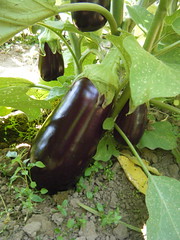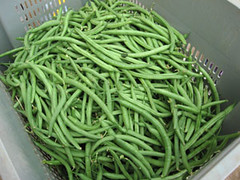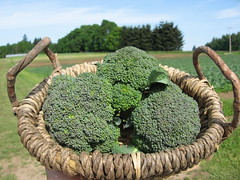This Week’ Share

On Rotation
Share Notes
- Beans: Staring in your shares this week you will start to see either Strike green beans or Dragons Tongue beans, which are green beans with beautiful reddish purple coloring.
- Kale: Lacinato kale, also know as Dinosaur kale or cavolo nero in Italian is an black Italian kale variety with deep blue-green ovular leaves.
Recipes
Beet Recipes
Note: Make sure to look at last week’s Blog for a beet recipe from Lincoln Restaurant’s Jenn Louis in the Chef’s Corner.
Beets with Fennel
From www.comingfordinner.com
Note: You can make this and then let it cool, and when you’re getting ready to eat, put the heat back under it to warm it up again.
4-6 beets (depending on size)
2 fennel bulbs
1 onion
Juice from 1 lemon
1/3 cup white wine
2 tablespoons whole grain Dijon mustard
2 tablespoons olive oil
2 tablespoons butter
Salt
Black pepper
Bring a pot of water to a boil. Peel the beets and put into the boiling water. You’ll want to let them cook for about 15 – 20 minutes (when a knife easily goes into them). Once they’ve cooked, drain them and set them aside to cool. Cut your onion in half, and cut those halves into slices. Do the same with your fennel and your beets. Put your olive oil and butter into a medium stock pot and set it over medium heat. Add in your onion, fennel, salt, and pepper, and cook for 5 minutes. After 5 minutes, add in your white wine, mustard, and lemon juice. After another 5 minutes, add in your beets. Cook for another 5 minutes.
Roasted Beet Crostini
From Eating Well in Season by Jessie Price
Note: This is a tasty and colorful starter for entertaining or just fixing up for a pre-dinner delight. Note that you will end up with some left over cooked beets that you can you use in a side dish or salad, or any other way you please.
1 bunch beets with greens attached
16 ½-inch thick slices baguette, preferably whole-grain cut on the diagonal
2 tablespoons extra virgin olive oil, divided
6 cloves garlic, minced
1 tablespoon sherry vinegar or red-wine vinegar
2 tablespoons water
¼ teaspoons salt
4 ounces creamy goat cheese
¼ teaspoon freshly ground pepper
Preheat oven to 400˚F. Trim greens from beets, reserving stems and greens. Place the beets in a baking pan, cover with foil and roast until very tender when pierced with a knife, 45 minutes to 1½ hours depending on the size of the beets. Uncover and let cool. Reduce oven temperature to 350˚F. While the beets cool, arrange baguette slices in a single layer on a large baking sheet. Bake, turning the slices over once halfway through, until toasted but not browned, about 14 minutes. Thinly slice the beet green stems and finely chop the leaves; keep the stems and leaves separate. Heat 1 tablespoon olive oil in a large skillet over medium heat. Add the stems and cook, stirring occasionally, until tender, about 3 minutes. Add the remaining 1 tablespoon oil and garlic and cook, stirring, until fragrant, about 15 seconds. Add the greens, vinegar and water and cook, stirring occasionally, until greens are tender and liquid has evaporated, 4 to 5 minutes. Stir in salt and remove from heat. Peel the cooled beets and cut into 1-inch pieces. Place ¾ cup beet pieces, goat cheese and pepper in a food processor or blender and puree until smooth (reserve the remaining beets for another use). To assemble crostini, spread about 2 tablespoons beet-cheese spread on each slice of toasted baguette and top with sautéed greens. Makes 16 crostini.
Fennel Recipes
Greek Fennel Skillet
From Simply in Season by Mary Beth Lind and Cathleen Hockman Wert
Note: Serve plain as a side dish or make it a meal by serving this savory sauté over pasta or polenta. It can also top Italian bread which has been brushed with olive oil and toasted.
2 cloves garlic, minced
2 fennel bulbs, julienned
1 large onion, julienned
1 tablespoon lemon juice
3 medium tomatoes, chopped
Salt and pepper, to taste
1½ cups feta cheese, crumbled or Mozzarella, shredded
½ cup black olives, optional
In a medium skillet sauté minced garlic in 2 tablespoons olive oil for 1 minute. Add and the fennel and onions and sauté until tender, 5 to 10 minutes. Add the lemon juice and tomatoes and cook over medium heat until part of the liquid evaporates, 10 minutes. Add salt and pepper to taste. Stir in the cheese and black olives and serve.
Beets with Fennel
(see above in Beet Recipes)
Kale Recipe
Summer Lasagna
Adapted from the Rolling Prairie Cookbook by Nancy O’ Connor
1 tablespoon olive oil
2 to 4 cloves garlic, minced or pressed
1 medium onion, chopped
2 smaller zucchini or patty pan squash, chopped
1 tablespoon fresh basil (or 1 teaspoon dried)
1 quart pasta sauce (homemade recipe below in Tomato Recipes, or already prepared works too)
9 lasagna noodles (approximately ½ pound)
1 bunch Lacinato kale
1½ cups low-fat Ricotta or cottage cheese
1 beaten egg white
¼ teaspoon salt
freshly ground black pepper
½ pound Mozzarella, grated
½ cup grated Parmesan
Heat oil in a large saucepan or deep skillet over medium heat and sauté garlic, onion, and summer squash until just barely tender. Stir in basil and pasta sauce and allow to simmer over low heat while you prepare the rest of the lasagna. Cook lasagna noodles in boiling water until just barely tender. Drain and rinse with cold water (I like to lay my cooked noodles out on the counter so they won’t stick together). Wash kale well, trim the tough stems, and steam or boil whole leaves until they are just tender. Drain leaves well, squeeze out excess water, and chop. Mix Ricotta/cottage cheese and egg white together thoroughly. Season with salt and pepper. Blend in kale. Now you are ready to assemble. Preheat oven to 350˚F. Place ¼ cup of the sauce in the bottom of a 9 x 13-inch baking pan. Line the bottom of the pan with 3 of the cooked lasagna noodles. Spread half of the Ricotta/cottage cheese mixture on the top of the noodles. Cover this with half of the Mozzarella. Top this with a third of the sauce, spreading as evenly as possible. Repeat with 3 more noodles, the remaining Ricotta/cottage cheese, the remaining Mozzarella, approximately half of the sauce you have left, and cover all this with the last 3 noodles. You should have just enough sauce to cover the top of the noodles. Sprinkle with Parmesan. Cover the pan with foil and bake for 40 minutes. Remove the foil and bake for another 10 to 15 minutes, uncovered. Remove from the oven and allow to sit several minutes before serving. Serves 8.
Tomato Recipe
Note: Make sure to look at last week’s Blog for a tomato recipe from Lincoln Restaurant’s Jenn Louis in the Chef’s Corner
Basic Tomato Sauce
Adapted from The San Francisco Chronicle, www.sfgate.com
Note: If you are making this for use in the Summer Lasagna recipe included above you can make the sauce up to 5 days ahead of time and store in the refrigerator until you are ready to use in the lasagna. If you are using Roma-type tomatoes (San Marzano Paste Tomatoes from your share), the cooking time will be less. Use on pizza, polenta, pasta, pan-seared steak or any time tomato sauce is required.
2 tablespoons extra-virgin olive oil
¼ cup minced onion
3 stalks celery with leaves, chopped
2 cloves garlic, minced
5 pounds medium to large juicy tomatoes, any variety, cored, peeled (optional) and coarsely chopped
1 tablespoon minced fresh thyme
1 tablespoon minced fresh rosemary
2 bay leaves, fresh if possible
Kosher or sea salt and pepper, to taste
In a large pot, heat the olive oil over medium high heat. When warm, add the onions celery and cook until translucent, 2 to 3 minutes. Add the garlic and cook another minute, until softened. Add the tomatoes, increase the heat to high and bring to a boil, stirring occasionally. Add the thyme, rosemary and bay leaves. Reduce the heat to medium and cook, stirring from time to time, until the sauce has thickened so much you can almost stand a wooden spoon upright in it, about 1½ hours. You will hear the bubbling as it thickens, indicating it is almost ready. To finish, reduce the heat to low, and simmer, stirring until the desired thickness. Be careful not to burn the sauce. Taste, and add salt and pepper as desired. Puree or leave chunky, whichever you prefer. Cool and store up to 5 days in the refrigerator, or freeze. Makes 1½ quarts.
Greek Fennel Skillet
(see above in Fennel Recipes)
FIT Spotlight: Justin

Justin moved to Portland to be closer to family and found that he loved Portland, especially the outdoors. After spending a year doing salmon habitat restoration through AmeriCorps, and becoming an enthusiastic gardener in his free time, Justin wanted to learn more about sustainable food systems and local agriculture. Justin found both the community component of the SIO FIT Program and the accessible location of Sauvie Island appealing, and joined the crew in May. Out at the farm Justin enjoys harvesting melons because, “the smell in the field is amazing and you bring back so much bounty in one trip.” Since working at the farm Justin feels he better understands the, ‘”full value of farming,” and all of the hard work it takes to get to the harvesting of the crops. He enjoys positive work environment, especially working with the crew and “having fresh food at your fingertips!”




















